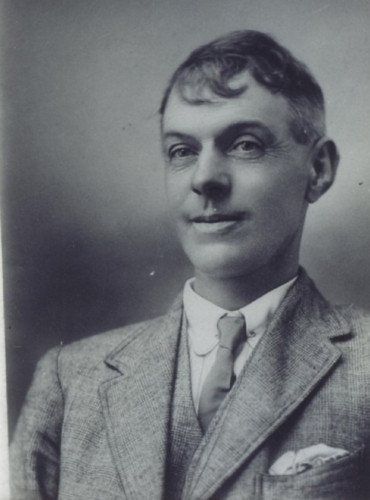South Coast NSW History Story
John Gilmore, Quarry Manager
John Gilmore was the Quarry Manager at the Moruya Granite Quarry (also known as the ‘Government Quarry’ and the ‘Public Works Department Quarry’) from the time it was taken over by Dorman, Long and Company (who were building the Sydney Harbour Bridge) in late 1924 until it was closed in early 1932.
During that period 173,000 blocks of granite were shipped to Sydney for cladding the piers and pylons of the Sydney Harbour Bridge (these were precision cut and shaped, and numbered so they could be later fitted together in Sydney like pieces of giant jigsaws) and 23 enormous blocks of granite, including one weighing 20 tons, were supplied to form the Sydney Cenotaph.
Remarkably, the level of craftsmanship at the Moruya Granite Quarry was so high that not a single one of these blocks of Moruya granite was rejected and therefore had to be replaced.
John’s role, as Quarry Manager, extended far more widely than simply supervising the cutting and shipping of stone. He initially needed to supervise the erection of all facilities on the site on the northern bank of the Moruya River (these included two wharves, a power house, three enormous sheds, an office, a blacksmith’s shop, a crushing plant, conveyor belts, a railway line to the wharf and numerous cranes; he also organized for a masonry wall to be built to protect the site from the effects of possible river flooding, which evidently resulted in him being chastised by Dorman, Long and Company. However, only minimal damage resulted in the machinery shed in the ‘frightful’ flood of 1925), the building and then the running of a town to house many of the 250 quarry employees and their families (‘Granite Town’, just to the west of the Moruya Granite Quarry, included 67 simple houses (with detached bathroom facilities shared between two families), bachelors’ quarters, quarters for the Italians, a post office, a co-operative store, a hall and a school), and the recruitment and training of the employees (which included large contingents of skilled Scottish and Italian stonemasons (one account indicates ‘the Italians had their own bachelors’ quarters, employed their own cook and lived very well’) because there was then a shortage of stonemasons in Australia).
John was born in Scotland. He attended ‘school until the age of 13 and was taught by Mr William Alexander. One day in class, John was not paying attention so Mr Alexander threw a strap at him. Young John retorted by picking up the strap and hitting Mr Alexander with it – then promptly left school, vowing never to return.
John went to work at Kemnay Quarry as an apprentice with his father and returned to night school at the age of 17 to learn mathematics, a subject he required to work out the dimensions of the stone he worked…At the age of 19, he was Manager of the Rubislaw Quarry, where it was said of him “What he doesn’t know about granite quarrying, very few people are ever likely to find out”.’
In 1924 ‘Mary Gilmore (John’s wife) came across an advertisement for the position of ‘Quarry Manager‘ whilst unpacking groceries – reading the paper wrapped around some meat. They were offering such good conditions – 5 years work, cheap housing and wages of £6.16.8 per week. On behalf of her husband, Mary wrote out an application for the position and sent it off to London…’ and soon they, and their nine children, were on their way to Moruya.
John and his family lived across the Moruya River from the quarry in ‘Tuffwood’, a house originally owned by Arthur Halley Preddey. Initially he rode a horse to work but later Dorman, Long and Company provided him with a motor launch so he could more-easily cross the river. He named it ‘The Bon Accord’, Aberdeen’s (Scotland) motto meaning ‘goodwill’.
The Gilmore home rapidly became renowned for its hospitality, and it seems that John and Mary ‘radiated a spontaneous captivating charm which had a rare quality because they were quite unaware of it themselves’.
After completing his contract with Dorman, Long and Company, John worked for the NSW Department of Main Roads and in New Zealand before he and Mary retired in Moruya.
John’s significant contribution to the construction of the Sydney Harbour Bridge and Sydney Cenotaph is recognised locally with the rotunda in Moruya Quarry Park (on the northern bank of Moruya River, on the Moruya Granite Quarry site) having been named in his honour.
J.J.C Bradfield’s (the civil engineer who oversaw the construction of the Sydney Harbour Bridge) observation that ‘the granite-faced abutment towers and pylons, simple and elegant, are the architectural features of the bridge - which would otherwise be an immense utilitarian steel structure’ is recognition from further afield of the enormously-important contribution that John Gilmore made from Moruya to that project.
Postscript: The Australian Cricket Captain Bob Simpson’s parents were among those who lived at the Moruya Granite Quarry. Jock was a stonemason.
Sources: Information from Norm Moore of Moruya; ‘Not Forgotten: Memorials in Granite’ by Christine Greig; moruyastoryline.com.au; ‘To Make a Bridge. Where Did the Granite of the Sydney Harbour Bridge Come From?’ in Traces magazine, 19.4.2014; ‘Gold-and-Granite’ (on-line) Moruya District Historical Society; ‘Granite Town – Moruya River. A Chronicle of Almost Forgotten People who Quarried for the Sydney Harbour Bridge’ by Nigel Neilson; monumentaustralia.org.au
